
Reference: 2071570


Its aroma is robust, woody, and powerful, reminiscent of forest undergrowth yet floral.
Its flavor pairs particularly well with meats, pâtés, charcuterie, biscuits, gingerbread, and certain sauces.
 Delivery
Delivery
Mondial Relay
 Returns
Returns
See conditions
 Payments
Payments
100% secure
- Livré en sachet refermable -
***
Uses in Cooking and Beyond:
Ground cloves are essential in blends for gingerbread, biscuits, curries, meats, pâtés, and charcuterie, especially in the "four-spice" mix, where cloves are a key ingredient. Due to their powerful taste, they should always be used sparingly in dishes.
Whole cloves can be studded into an onion to flavor meat and fish broths. They also add aroma to marinades, sauerkraut, and even teas. In Northern and Eastern regions, cloves are pushed into an orange until it’s completely covered and then hung in closets to repel insects, particularly moths. Thanks to the antiseptic properties of cloves, the orange dries without rotting, gently scenting the linen.
The shiny leaves of the clove tree are also very useful as they yield an essential oil rich in eugenol, a key component in the production of artificial vanillin.
Who am I?
Origin: Madagascar
Scientific name: Eugenia caryophyllus
Clove is actually the flower bud of the clove tree, a cone-shaped tree in the Myrtaceae family, native to the Moluccas Islands in Indonesia. When mature, the tree can reach up to 20 meters in height. Its evergreen leaves are oval and leathery. The flowers, with four pale pink petals, are distinguished by their intense red sepals. They are fragrant and arranged at the top of branches. Before blooming, the flower buds resemble small nails, hence the name "cloves." They are harvested at this stage and dried in the sun until they turn dark brown.
Today, Indonesia remains the world’s largest clove producer, though the tree also thrives in Réunion, Madagascar, Zanzibar, and the Caribbean. Low rainfall results in higher-quality crops. A mature tree yields an average of 6 to 16 kg of cloves per year.
Clove is known for its antiseptic and anesthetic properties, making it widely used in dental care and very effective for alleviating toothaches (though it doesn’t replace a dentist visit, it can help ease the pain).
Clove is also an ingredient in kohl, an eye makeup pencil.
In recent years, the demand for cloves has surged, as 95% of global production is now used for kreteks, Indonesian clove cigarettes, misleadingly marketed as harmless. This high demand has led to a scarcity of cloves, driving up their price significantly.
A Bit of History:
Indian writings from 200 B.C. already mention the trade of this spice. The Chinese were using cloves as early as 206 B.C., chewing them for fresh breath and for their medicinal properties. The ancient Greeks and Romans were also familiar with cloves.
In Europe, it was the Arabs who introduced cloves in the 4th century A.D., and the spice became very fashionable during the Middle Ages.
The Portuguese, who arrived in the Moluccas in 1424, seized control by burning clove trees outside Ternate, where they held a monopoly. Pierre Poivre, then an intendant of Mauritius, managed to smuggle some clove plants during an expedition, eventually acclimating them first in Mauritius and then in the Caribbean.
Data sheet
Reference: 2071570
Reference: paindepices
Reference: quatreepices
Reference: anisvertM
Reference: 00723801
Reference: Selpoivre5baies
Reference: 3N7201902
Reference: gingembreE
Reference: paella
Reference: 10203601
Reference: 810220
Reference: L0001204690
Reference: 1P8600602
Reference: 6L5609803
Reference: apache
Reference: 10M6821604
Reference: 20715402
Reference: laurierE

Its aroma is robust, woody, and powerful, reminiscent of forest undergrowth yet floral.
Its flavor pairs particularly well with meats, pâtés, charcuterie, biscuits, gingerbread, and certain sauces.